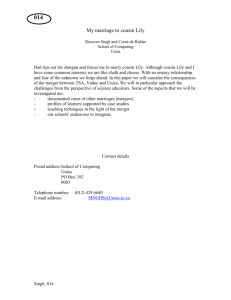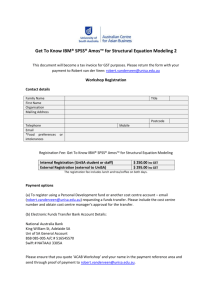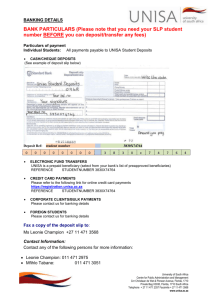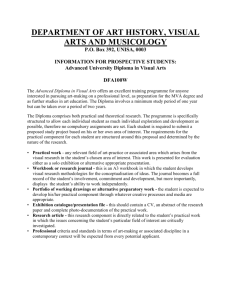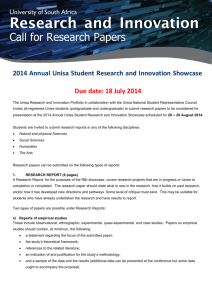Transforming Teaching and Learning at an Institutional Level – A
advertisement
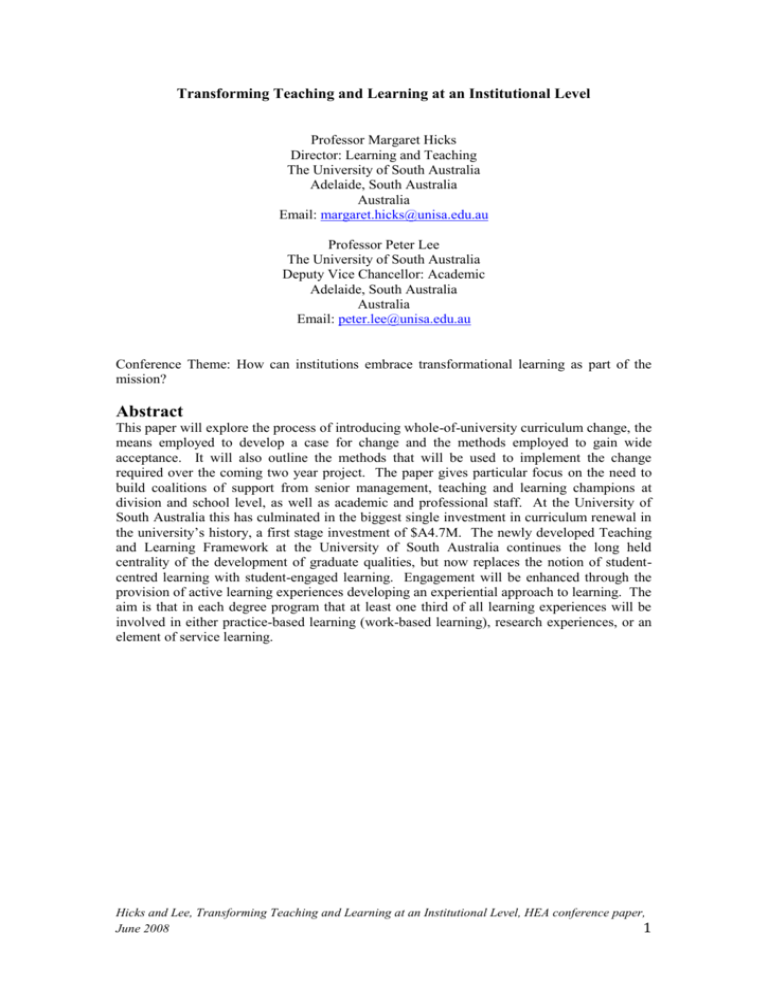
Transforming Teaching and Learning at an Institutional Level Professor Margaret Hicks Director: Learning and Teaching The University of South Australia Adelaide, South Australia Australia Email: margaret.hicks@unisa.edu.au Professor Peter Lee The University of South Australia Deputy Vice Chancellor: Academic Adelaide, South Australia Australia Email: peter.lee@unisa.edu.au Conference Theme: How can institutions embrace transformational learning as part of the mission? Abstract This paper will explore the process of introducing whole-of-university curriculum change, the means employed to develop a case for change and the methods employed to gain wide acceptance. It will also outline the methods that will be used to implement the change required over the coming two year project. The paper gives particular focus on the need to build coalitions of support from senior management, teaching and learning champions at division and school level, as well as academic and professional staff. At the University of South Australia this has culminated in the biggest single investment in curriculum renewal in the university’s history, a first stage investment of $A4.7M. The newly developed Teaching and Learning Framework at the University of South Australia continues the long held centrality of the development of graduate qualities, but now replaces the notion of studentcentred learning with student-engaged learning. Engagement will be enhanced through the provision of active learning experiences developing an experiential approach to learning. The aim is that in each degree program that at least one third of all learning experiences will be involved in either practice-based learning (work-based learning), research experiences, or an element of service learning. Hicks and Lee, Transforming Teaching and Learning at an Institutional Level, HEA conference paper, June 2008 1 Introduction Improving the quality of a student’s learning experience is essential for all universities. While this can be achieved in many ways, of central importance is students’ engagement with the curriculum. Through this paper we explore the process of introducing whole-of-university curriculum change as a central driver in transforming learning and engaging students as part of the University of South Australia’s newly defined mission1. After establishing the case for change, we then describe the three stages of implementation and in doing so highlight a number of lessons we have learnt from this experience. An institutional approach to curriculum renewal In formulating our approach to a whole-of-institutional approach, we were mindful of three challenges. The first is that curriculum design and any related improvement strategies are often dealt with at an individual level. The second is the difficulty of implementing any large scale university-wide change which is realised beyond strategy and framework statements that appear on university websites or in position papers. Thirdly, our students were telling us through our surveys that there was a lack of engagement with their learning – a challenge which was not unique to the University of South Australia. At the university level, much curriculum design is dealt with at the individual subject/unit/course level. Traditionally, it has been the prerogative of the individual lecturer to outline and design the curricula of their individual teaching. Often (and not ideally) this is done without reference to other subjects which are taught in the same award program. The move to defining and articulating graduate attributes at a program level over the last fifteen years has challenged this model of individualistic practice and in many universities facilitated broader discussion at a program level about curriculum decisions. Similarly, the introduction of new technologies in teaching has resulted in different delivery modes and has been a driver for changed curriculum practices. But even with these broader imperatives, it is still often easy to revert to individualistic and private practices of curriculum design and revision, and institutional change practices, while well intended, are not fully realised. Most universities now have publicly stated teaching and learning strategies, frameworks or other statements about their teaching and learning purpose available on their websites and in official documentation. It is acknowledged that there is variance in the extent to which these statements are being implemented and used within individual institutions. Gibbs, Habeshaw and Yorke’s (2000) survey of United Kingdom institutional implementation of teaching and learning strategies while stating that strategy implementation takes time, concluded that there was considerable variation across the sector and for some institutions this has not moved beyond a paper-based exercise. Newton (2003) identifies five concepts which can be barriers to successful implementation of learning and teaching strategies. These include: (a) loss of ‘front-line’ academics’ autonomy; (b) policy and strategy overload; (c) bureaucratisation of teaching; (d) local practices and local culture; (e) the ‘shift from teaching to learning’. (Newton, 2003, p 432) It is important to take these concepts into consideration when introducting new strategies and implementing change at an institutional level. Recent feedback from students nationally and internationally has focused on how students ‘engage’ with their learning (Krause, 2005; Yorke, 2006). Within the Australian context the 1 UniSA’s vision statements is available at: http://www.unisa.edu.au/about/intro/vision.asp Hicks and Lee, Transforming Teaching and Learning at an Institutional Level, HEA conference paper, June 2008 2 concept of student engagement has been defined as ‘students’ involvement with activities and conditions likely to generate high-quality learning’ (ACER, 2008, p1). Engagement with their learning is being seen as the most important factor in determining the quality of the learning experience. Central to this concept is the curricula. In determining an approach to a whole-of-institution curriculum renewal, all of these factors have been considered and have informed the approach taken. In the next section we turn to the University of South Australia as a specific case-study to explore these changes in detail. Background The University of South Australia (UniSA)2 was founded in 1991 from a number of predecessor institutions that can date their existence to the late nineteenth century. As a very young University, it has faced considerable challenges in transforming itself from a teachingonly college of advanced education to one that is now rated number 13 out of 38 Australian universities in terms of total research income (DEST, 2006). Its founding act requires the University to pay particular attention to the provision of educational opportunities for those from disadvantaged educational backgrounds as well as indigenous Australians. Uniquely in Australia, it has set itself a goal that by 2010 all programs will include the equivalent of one course on indigenous perspectives and has already achieved this goal in some 75% of its programs. This has not been easy work, but is a discussion for another forum. It is also a very large University, with nearly 34,000 students currently enrolled in some 400 programs of study in 2300 individual courses. It teaches on 4 campuses located in Adelaide, and in two regional cities in South Australia. It teaches 11,000 international students, with approximately half of theses students located in Adelaide, but significantly, half based in Singapore, Kula Lumpur, Hong Kong, and other cities in South East Asia and central Asia. Many of the programs offered are professionally oriented and directly applied within a professional context. The University has a proud tradition of providing flexible learning opportunities to a wide cohort of students, originally as a designated distance education provider by the Federal Government of Australia (King, McCausland and Nunan, 2001). This work continues with nearly all courses now having an on-line presence, as an active and growing participation in the delivery of on-line education through Open Universities Australia. Very early on its existence, the University adopted as a founding principle of curriculum design the embedding of graduate qualities (Nunan, George and McCausland, 2002). It was one of the very first in Australia to demand that all programs at the University develop a set of graduate qualities and to demonstrate that these qualities were developed through purposeful student experiences interpreted through a discipline context. These graduate qualities are such that a UniSA graduate: 1. operates effectively with and upon a body of knowledge of sufficient depth to begin professional practice; 2. is prepared for life-long learning in pursuit of personal development and excellence in professional practice; 3. is an effective problem solver, capable of applying logical, critical, and creative thinking to a range of problems; 4. can work both autonomously and collaboratively as a professional; 5. is committed to ethical action and social responsibility as a professional and citizen; 2 UniSA’s home page can be accessed at: http://www/unisa.edu.au Hicks and Lee, Transforming Teaching and Learning at an Institutional Level, HEA conference paper, June 2008 3 6. communicates effectively in professional practice and as a member of the community; 7. demonstrates international perspectives as a professional and as a citizen. Each of these statements are backed by a set of indicators that describe how students may demonstrate these qualities3. While initially resisted by many staff who believed that the development of such qualities could not occur without the displacement of content specific knowledge, they are now well entrenched and accepted at UniSA. The University has adopted student-centred approaches not only to the provision of direct learning experiences, but also to the provision of services and administrative support. This is particularly evident through the extensive development of on-line support materials for such issues as student orientation experiences, learning developmental practice, IT support, enrolment and program administration and information literacy development. These elements of the UniSA experience: Graduate Qualities, Student Centred Experiences provided through a Flexible Delivery method were seen as defining the unique student experience for the past decade. Establishing the case for change Transforming itself from a teaching-only institution to one that is increasingly recognised for its research has created three internal tensions. Firstly, it has placed a greater demand on staff who are now expected to both conduct quality research that has impact in the wider community, economically and or socially, as well as provide quality learning experiences for our students. This has occurred through a period of tightening economic resources that have resulted in the student to staff ratio increasing from approximately 14 to 1 to now approximately 20 to 14. Secondly, the increased “volume” of the research agenda, particularly surrounding the introduction of a research quality assessment exercise introduced by the Australian Federal Government, has made it more difficult to keep the teaching agenda on the “front burner”. Staff have certainly perceived that perhaps good teaching is no longer valued by the institution. Thirdly, the University has indeed channelled more of its capital into research, creating high quality centres of excellence that have national and international recognition. This has been good for the organisation as a whole, but has in some quarters reinforced the message that teaching does not matter. One of the challenges of the future is to re-engage these centres of excellence, both the staff and physical resources back into the undergraduate mission of the University. The Federal Government also became concerned with the increased attention being given to research outcomes in the sector as a whole, and in 2005 introduced a “Learning and Teaching Performance Fund” (LTPF). This fund, with an annual allocation of approximately $80 Details about UniSA’s graduate qualities can be found at: http://www.unisanet.unisa.edu.au/gradquals/staff/indicators.asp 3 4 Universities Australia website http://www.universitiesaustralia.edu.au/documents/publications/stats/Student-teacher-ratio-19902007.pdf Hicks and Lee, Transforming Teaching and Learning at an Institutional Level, HEA conference paper, June 2008 4 million p.a. was introduced to “reward excellence in teaching outcomes” and was specifically designed not to be “spread thinly across the sector”. As is always the case, the measurement of learning and teaching outcomes proposed in the LTPF was highly controversial. Claims of inappropriate metrics, very fine distinctions in actual performance between institutions being used to force a ranking, opaque statistical adjustment methods, lack of acknowledgment of individual university missions, regional differences, and indeed institutional history that meant some universities had the benefit of public funds for over 100 years while others had a little more than a decade all surfaced. However, despite all of these concerns over the three years that the process has operated, the government is able to claim a success for its policy initiative as universities have focussed increasing attention on learning and teaching. This is particularly acute as rankings and league tables are produced by local media outlets, to the embarrassment or joy of particular university administrations. The metric used in the Australian LTPF includes three scales and derives from an annual survey of graduates from all universities. Typical response rates range from 30 to 70% depending on university. The three scales are: 1. Graduate Satisfaction with the Good Teaching Scale comprising of six individual questions 2. Graduate Satisfaction with the Generic Skills Scale comprising of six individual questions 3. Graduate Overall Satisfaction Scale In addition, two measures of student “success” are used: 4. Retention Rate defined as the number of students who continue in university studies in the same university as a fraction of those who studied in the same university in the preceding year adjusting for graduating students 5. The overall progress rate as defined as the number of individual courses passed as a fraction of those courses attempted summed for all students. Finally, two measures of student outcomes are used: 6. The percentage of graduates in full time employment who were available for full time employment as measured four months after graduation. 7. The percentage of graduates who continued in either full or part time study In the first round of the LTPF these measures were used at whole of university level, but in subsequent rounds they have been used in four discipline clusters. UniSA has not done well in these assessment exercises. Our own internal student feedback data predicted this outcome, but nevertheless, it came as a hard pill to swallow. The effect on internal morale was noticeable, and has taken several years to recover. The immediate response of senior management to the first round of results was to be seen to take action. It was long known within the University that assessment practice was not of world standard, with many courses overloaded with assessment tasks for students. The “crisis” of the first round results provided the platform to introduce institution-wide reform of the assessment practices, mandating that each course would only have three pieces of formal assessment, a total of 4500 words (or equivalent) of student assessable work, and that one piece of assessment must occur in the first third of the course and be worth no more than 15% of the final grade. Lesson 1: Crises can be useful for introducing radical change quickly This change in assessment practice was introduced with very little consultation with the broader academic community and there was little initial support for the change. As observed Hicks and Lee, Transforming Teaching and Learning at an Institutional Level, HEA conference paper, June 2008 5 by Newton (2001), academic staff felt that their autonomy was lost. However, the policy was mandatory and audits were conducted to ensure compliance. Three years later, internal student feedback is showing improvement in students’ perception of the appropriateness and evenness of the workload between courses. However, the manner of introduction of the policy has made the policy still resented by staff, even despite the positive data that is emerging. During 2008, the policy is being reviewed to create a bit more flexibility to allow more innovation in assessment practices. Lesson 2: Academic policies require the broad support of the academic community to build trust and effect long term change. Subsequent to the initial response, a more detailed analysis of the results obtained from the LTPF revealed some underlying weaknesses at UniSA. Figures 1 and 2 highlight the gap between UniSA and national benchmark data that clearly demonstrates that firstly, UniSA is not performing as well as others on the Good Teaching Scale (Figure 1), and that the underlying cause of this gap lay in the affective domain of teachers (Figure 2). Lesson 3: There is never any substitute to careful analysis of available data – let the data speak. Figure 1: UniSA forecast results on the 2008 LTPF by discipline benchmarked against 2007 Band A1 and A2 minimum cut-offs Hicks and Lee, Transforming Teaching and Learning at an Institutional Level, HEA conference paper, June 2008 6 Figure 2: Good Teaching Scale staff attributes UniSA All Unis Top10 pass mark UniSA GTS All Unis Top10 pass mark GTS 100% 100% GTS27 GTS01 GTS27 GTS01 90% 90% 80% 80% GTS16 GTS03 GTS15 GTS16 GTS10 GTS03 GTS15 UniSA UniSA All Unis GTS10 All Unis Top10 pass mark Top10 pass mark GTS 100% GTS 100% GTS27 GTS27 GTS01 GTS01 90% 90% 80% 80% GTS16 GTS03 GTS15 GTS10 GTS16 GTS03 GTS15 GTS10 GTS01: ‘time into commenting on my work’ GTS03: ‘helpful feedback’ GTS10: ‘motivated me to do my best work’ GTS15: ‘extremely good at explaining things’ GTS16: ‘make their subject interesting’ GTS27: ‘understand difficulties I might be having with my work’ Formulating a response In addition to the data obtained from the national Learning and Teaching Performance Fund, UniSA conducted the third of its Student Experience Questionnaires in 2006. These surveys, run every 2 years, provide a rich source of information, not only on students’ perception of courses and teaching, but on the broader experience at University. The 2006 results are summarised in Figure 3 which produces an evaluation of the relative importance of particular components of the student experience, and a relative rating of how well the students rated our performance on each factor. Hicks and Lee, Transforming Teaching and Learning at an Institutional Level, HEA conference paper, June 2008 7 SEQ Priority Matrix Figure 3: Student Experience Questionnaire 2006 priority matrix Maintain 5.00 Maintain or Improve 4.50 Performance (mean) 4.00 3.50 3.00 2.50 2.00 1.50 1.00 0.50 0.00 0.00 Monitor 0.50 Top Priority 1.00 1.50 2.00 2.50 3.00 3.50 4.00 4.50 5.00 Impact (lowest to highest) Program Experiences Student Engagement Program Resources Tangibles Safety Program Services IT Support Program Support This analysis clearly showed that the University needed to improve the program experience and student engagement. The way forward for the University now clearly involved: 1. increasing student engagement 2. engaging academic staff in major curriculum renewal 3. illustrating the University was willing to commit resources to improving the teaching performance of the University 4. raising the profile of the importance of teaching, and 5. improving the morale of teaching staff, whilst acknowledging the history of the organisation, both as an emerging university and its antecedent teaching-only organisations. A series of workshops with teaching staff were held in which these issues were explored, data presented and ideas sought. In all, over 150 staff were consulted in small groups, as well as school and division (faculties at UniSA are known as divisions) meetings. At the same time, it was important that as much tension between the research and teaching agendas of the University were removed and “harmonised” in any new teaching and learning framework. Extensive discussions and workshops were held on the “teaching – research nexus” jointly sponsored by the Deputy Vice Chancellors Academic and Research. The symbolism of having both Deputy Vice Chancellors discussing these issues was and remains extremely important. Lesson 4: On major policy development, it is important that all of the senior leadership group support and sponsor the direction to be taken The time period between UniSA receiving its first results from the LTPF to the launch of the University’s new teaching and learning framework was three years. Consultations with staff about the new teaching and learning framework and subsequent discussions and workshops were held over a twelve month period. The time-frame to implement the new framework is planned for a three year period. Hicks and Lee, Transforming Teaching and Learning at an Institutional Level, HEA conference paper, June 2008 8 Lesson 5: Implementing change takes considerable time and can not be hurried The New Teaching and Learning Framework The new framework’s principal function is to indicate the key elements of our teaching and learning activity and the relationships between them. These include a renewed commitment to UniSA’s graduate qualities, student engagement, and flexible learning environments. It indicates a coherent process linking intentions, implementation activity, outcomes and reflections on improvements. In this, it is not unlike an Approach-Deployment-ResultsImprovement (ADRI) cycle often used for quality assurance and accountability purposes. Where educational models and quality assurance cycles differ is in the weighting given to the linearity of decision-taking processes. The ADRI cycle involves a definite step-by-step rationality; educational models tend to acknowledge the complexity of interactions between their composite elements. It has been constructed to reflect both a spiral of activity but also acknowledge that the component elements impact on each other in dynamic ways. For the purposes of accountability – we wish to think of the framework in terms of an ADRI cycle, we can describe it as follows. 1. Approach involves the factors which shape our thinking and the way we go about planning for the future, i.e. moving from our core values, reflected in commitments of access to, equity within and quality throughout our programs; guided by our establishing Act of Parliament, the University Mission and its Statement of Strategic Intent; and acknowledging the force of both the local and international contexts of higher education. 2. Deployment refers to implementing our teaching and learning framework and we describe here the elements that shape teaching and learning (the centrality of Graduate Qualities in all teaching and learning arrangements); how we implement them (fostering student engagement facilitated by the provision of flexible learning environments); and our acknowledgement of the importance of disciplinary knowledge, the teaching-research nexus, the critical experiential dimension of practice based learning, and learning through service to others. 3. Results are reflected in the outcomes of teaching and learning as manifest in the performance of our graduates in relation to their professional expertise, generic skills (e.g. communication abilities, collaboration abilities, information literacy or problem solving skills), and personal attributes (e.g. commitments to ethical behaviour, continuing professional development and having international perspectives on their professional activity). We discharge our mission as a university by developing graduates who can meet the intellectual, civic, and professional needs of society and industry. 4. Improvement should be evidence based, taking account of the way students report their experience, feedback from other stakeholders (e.g. government, the professions and their associations, employing bodies), and the extent to which we meet standards established through benchmarking. These evidence sources are used both in our internal planning, review and improvement processes, and also through external validation (e.g. Australian University Quality Agency audits and professional accreditation). The deployment element of the new Teaching and Learning Framework is best illustrated in Figure 4. Hicks and Lee, Transforming Teaching and Learning at an Institutional Level, HEA conference paper, June 2008 9 Figure 4: UniSA Teaching and Learning Framework, deployment element The challenge of the new framework for a University of the size of the UniSA is in implementing experiential learning across the breadth of the programs and for large class sizes. This cannot be achieved without the injection of new resources. Lesson 6: Major changes in machinery need oil – in the form of extra resources. Implementation The implementation of the new framework required both setting target and building a business case for the investment. The aim is by 2010, approximately one third of all learning experiences in all programs at UniSA will be related to any combination of the three elements of experiential learning: Teaching-research nexus Practice based learning Service learning Different programs may have different mixes of the three elements; however, the aim is for all programs to include some elements of all three components. The Student Engagement Project (STEP 2010) is a three stage process which began in September 2007 and is scheduled to finish in March 2010. Hicks and Lee, Transforming Teaching and Learning at an Institutional Level, HEA conference paper, June 2008 10 Figure 5: Transformation timeline Stage one - Business analysis This involves a review of all UniSA programs currently offered against four categories of indicators: Market position Program quality Financial viability Capacity/Constraints A Program Review Team comprised of senior staff from across the University conducted a strategic analysis of each program based on data collected in the four categories. Stage two - Program design In stage 2, the Head of School and Dean: Teaching and Learning in each Division are working together as 'Joint Project Sponsors' to decide which aspects of the Teaching and Learning Framework require most attention within those programs identified as 'ready for investment' in stage 1. This is requiring a review of the current status of those programs in relation to the three elements of experiential learning using the mapping techniques developed by the Learning and Teaching Unit. Heads of Schools are consulting with staff to review the status of programs in their respective Schools and seek input on the future design of programs. Once mapping is completed, the key questions are what are the strengths and opportunities for development of each program in relation to engaging students through experiential learning. A full SWOT (strengths, weaknesses, opportunities, threats) analysis may be helpful at this time. Towards the end of stage 2, the Head of School will develop an action plan for curriculum development that summarises the outcomes of the mapping activity indicating main areas of improvement and action to be addressed in stage 3 (implementation) of the STEP 2010 process. This plan will form the basis of a submission to the Division Pro Vice Chancellor and Deputy Vice Chancellor: Academic for stage 3 funding. Hicks and Lee, Transforming Teaching and Learning at an Institutional Level, HEA conference paper, June 2008 11 In order for the Deputy Vice Chancellor: Academic to release the $20,000 stage 2 funding to a School a short paper (no more than two pages) was required from each school which provided the following information: 1. What courses in the programs deemed ‘ready for investment’ will be mapped in stage 2 (e.g. core only; streams; specialisations) 2. How will the elements of experiential learning be mapped across the programs (e.g. identification of opportunities; number of hours of student effort, the quality of the experience). One or more of these elements may be chosen. 3. Who and how will the mapping process be conducted and who will be consulted? 4. What will stage 2 funds be used for? 5. What is the projected timeline for the completion of stage 2? Stage two is expected to be completed in September 2008. Stage three – Implementation Funds will be allocated to Schools or groups of Schools to implement the approved planned curriculum changes and these will progress through Academic Board's normal process for approving changes to programs and courses. Heads of Schools will consult with staff in their respective School on the implementation of the curriculum changes and the impact of the changes on staff and students in the School. It is anticipated that different Schools will have different approaches and the curriculum changes will be progressively implemented across the University. Stage three is expected to begin in September 2008 and be completed by March 2010. Evaluating success As discussed above, the approach taken has been carefully based on detailed data analysis from a range of sources including data which informs market and competitor analysis as well as student satisfaction (both national data and internal UniSA data). This data will continue to be sourced to inform and monitor the process as Schools implement different strategies through the stages outlined above. Currently, the University is investigating ways to sharpen the information that it collects about student engagement and this will be an important consideration in evaluating the progress of this initiative. Of significance will be the use of the AUSSE (The Australian Survey of Student Engagement) survey which has been piloted in Australia in 2007/8 (UniSA was one of the pilot sites). Anecdotally, the Heads of Schools have informally commented on the process thus far (completion of Stage 1). In a recent meeting of Heads of School, they have collectively stated how empowered they have felt by the process. They have appreciated having the data considered in this stage pre-populated in a report. As part of this process each Head of School and program directors within their school met their Divisional Pro-Vice Chancellor and other University senior managers to discuss the results. While this may have first been interpreted as a daunting process, in fact the reverse was reported. Instead they have talked about a real sense of ownership, empowerment and positive support to make changes. Conclusion As can be demonstrated through this case-study, transforming teaching and learning at an institutional level is a complex and time intensive process. The University of South Australia Hicks and Lee, Transforming Teaching and Learning at an Institutional Level, HEA conference paper, June 2008 12 through its intent to improve student engagement is using an institutional-wide strategy to achieve this. Through this process a number of significant lessons have been learnt that can be generalised to other contexts. Importantly, this experience has shown that under-performance in teaching scores can be used positively to kick-start improvement. But to do so, commitment is needed from every level of the institution – senior managers, teaching staff and professional staff – all have a role to play in the change process. Commitment can be gained by using an evidence based approach. The detailed analysis of data was an important input for decision making in the first stage of this transformative process and will continue to be used to evaluate progress. Finally, no significant change of this magnitude can be hurried. It takes time and resources to fully achieve institutional change. References ACER, 2008, Attracting, Engaging and Retaining: New Conversations about Learning, Australasian Student Engagement Report, Australian Council for Educational Research (ACER), Victoria http://www.acer.edu.au/documents/AUSSE_07AustralasianStudentEngagementReport.pdf DEST (2006) Research Income and Publications by Sub Category, http://www.dest.gov.au/sectors/research_sector/programmes_funding/general_funding/rbgran ts/documents/2006researchincomeandpublicationsbysubcategory_xls.htm Gibbs G, Habeshaw T and Yorke M, (2000) Institutional learning and teaching strategies in English higher education, Higher Education, 40, p 351 – 372 King B, McCausland, H, Nunan T, (2001) Converting to Online Course and Program Delivery: The University of South Australia Case Study, International Review of Research in Open and Distance Learning, Vol 1, No 2, January, p 1 – 22 Krause K, Understanding and promoting student engagement in university learning communities, Centre for the Study of Higher Education, University of Melbourne, http://www.cshe.unimelb.edu.au/pdfs/Stud_eng.pdf Newton J, (2003) Implementing an Institution-wide Learning and Teaching Strategy: lessons in managing change, Studies in Higher Education, Vol 28, No 4, October, p 427 – 441 Nunan, T., George, R., & McCausland, H. (2000). Rethinking the ways in which teaching and learning are supported: the Flexible Learning Centre at the University of South Australia. Journal of Higher Education Policy and Management, 22(1), 85 - 98. Yorke, M, (2006), Student engagement: deep, surface or strategic? Keynote address at the 9th Pacific Rim First Year in Higher Education Conference, Brisbane, Australia, http://www.fyhe.qut.edu.au/past_papers/2006/Keynotes/Yorke.pdf Hicks and Lee, Transforming Teaching and Learning at an Institutional Level, HEA conference paper, June 2008 13
